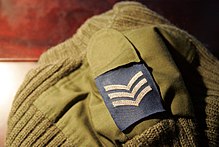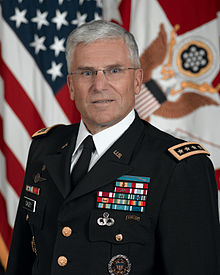Shoulder mark
The examples and perspective in this article deal primarily with the English-speaking world and do not represent a worldwide view of the subject. (July 2015) |


A shoulder mark, also called a rank slide or slip-on, is a flat cloth sleeve worn on the shoulder strap of a uniform.[1] It may bear rank or other insignia. A shoulder mark should not be confused with a shoulder board (an elaborate shoulder strap), a shoulder knot (a braided type of shoulder board), or an epaulette, although these terms are often used interchangeably.
Australia
[edit]The newer Auscam uniform design lacks shoulder marks, instead opting for a vertical strap in the middle of the chest region of the uniform. Rank insignia tags are slipped onto this strap. Unlike the older uniform designs, there are slip-ons for every rank in the Australian Defence Force.[citation needed]
The older Auscam uniform designs featured shoulder straps, upon which slip-on rank insignia of Commissioned Officers could be affixed, and non-commissioned officers in the Air Force and Navy only. No shoulder-strap slip-ons are available for enlisted members of the army, whereas the other two services had appropriate slip ons, who have rank patches sewed onto the uniform arms. This older design is no longer issued, but may still be seen on personnel whose most recent uniform issue pre-dates the use of the new design.[citation needed]
Canada
[edit]
In the Canadian Forces, slip-ons displaying rank insignia and shoulder titles are worn on the shoulder straps of the No. 3 Service Dress shirt, overcoat, raincoat, and sweater; CANEX parka and windbreaker; Naval Combat Dress jacket and shirt; flying suits and flying jackets; and Military Police Operational Patrol Dress shirt and jacket. The slip-ons are worn on a similar-style strap located in the centre of the chest (and sometimes centre of the back as well) of the CADPAT shirt, jacket, parka, and raincoat. Slip-ons are not worn on the Service Dress jacket, or with Mess Dress.
| Uniform | Base fabric | Officers' rank insignia | Non-commissioned members' rank insignia | Shoulder titles |
|---|---|---|---|---|
| Navy Service Dress | Navy Blue (which is a tone of black) [3] | Rows of gold rank braid | Embroidered in "CF Gold" thread | "CANADA", embroidered in "CF Gold" thread, only for NCMs. Officers have "CANADA" marks as shoulder flashes. |
| Army Service Dress | Rifle green | Embroidered in full colour, including branch-specific backing colour | None (rank insignia are worn on enameled pins on lapels or collar points) | Regimental or branch title, or the word "CANADA", in "CF gold" cotton thread |
| Air Force Service Dress | Air Force blue | Rows of "pearl grey" (silver) and black rank braid | Embroidered in "pearl grey" (silver) thread | "CANADA", embroidered in "pearl grey" (silver) thread |
| Naval Combat Dress and Naval Enhanced Combat Uniform - not a slip-on for NECU, but velcro-backed patch | Navy Blue | Rows of gold rank braid | Embroidered in "CF Gold" thread | "CANADA", embroidered in "CF Gold" thread |
| Navy CADPAT TW (Temperate Woodland) | Olive green | Embroidered in black thread | Embroidered in black thread | "CANADA", embroidered in black thread |
| Army CADPAT TW | CADPAT TW | Embroidered in "high visibility" silver thread | Embroidered in "high visibility" silver thread | "CANADA" or an applicable branch, regimental, or air unit title embroidered in "high visibility" silver thread |
| Air Force CADPAT TW and flying suit | Olive green | Embroidered in blue thread | Embroidered in blue thread | "CANADA" or an applicable branch, regimental, or air unit title embroidered in blue thread |
| Navy, Army, and Air Force CADPAT AR (Arid Region) | CADPAT AR | Embroidered in tan thread | Embroidered in tan thread | "CANADA" or an applicable branch, regimental, or air unit title embroidered in tan thread |
| Former uniforms | ||||
| Olive green combat uniform (replaced by CADPAT in the early 2000s) | Olive green | Embroidered in light olive green thread | Embroidered in light olive green thread[a] | "CANADA" or an applicable branch, regimental, or air unit title embroidered in light olive green thread |
| Air Force Service Dress prior to 2015 | Air Force blue | Rows of gold rank braid | Embroidered in "Old Gold" thread (darker in colour than "CF Gold") | "CANADA", embroidered in "CF Gold" thread |
United States
[edit]

Military
[edit]Based on the shoulder boards used by the United States Navy, the United States Army and Air Force developed the shoulder mark, a cloth tube with embroidered or pinned rank insignia. Army officer shoulder marks are colored depending on the branch with which the officer is affiliated. They have an 1⁄8-inch (3.2 mm) gold stripe below the embroidered grade insignia (the end far from the collar). In the Air Force, a similar stripe is limited to senior officers (majors and above). Air Force general officers have an additional stripe at the near end. Enlisted and Air Force junior officer shoulder marks lack these distinctions. These are worn on all class B uniform shirts. US Navy officers wear shoulder boards on Summer White and Service Dress White uniforms, and wool overcoats and reefers. "Soft shoulder boards" (shoulder marks) are worn on long sleeve white shirts and on black sweaters worn with Service Khaki or Service Dress Blue uniforms. Coast Guard officers wear Naval style shoulderboards on all class B uniform shirts. Service dress uniforms in the U.S. air and land forces also have a different style of shoulder board, a firm material with an underlying longitudinal strap. The corresponding jacket shoulder has two small loops traversing from rear to front, and the open end of the shoulder board's strap is drawn through the two loops and affixed to the underside of the board. This effectively hides all the means of attachments, leaving a firm, finished surface. This particular style is what U.S. Air Force personnel call a shoulder board. The shoulder sleeve is called an epaulette, and the two are never confused.
On the United States Army Blue Service Uniform, officers wear embroidered rank insignia "shoulder straps" (attentes[citation needed]) mounted lengthwise on the outside shoulder seams. These are 1+5⁄8 inches (41 mm) wide by 4 inches (100 mm)/3+1⁄2 inches (89 mm) (large size/small size) long, and are sewn, snapped, or clipped onto each shoulder.[4]
Boy Scouts of America
[edit]The Boy Scouts of America uses colored shoulder loops worn on the shoulder straps to indicate the program level. Webelos Scouts wearing tan uniforms and all Cub Scout leaders wear blue loops, Boy Scouts and leaders wear forest green loops (changed from red in 2008),[5] Varsity Scouts and leaders wear blaze (orange) loops, and Venturers and leaders wear emerald green loops.[6] Adults who hold a district or council position wear silver loops; those with section, area, regional, or national positions wear gold loops, and those with international positions wear purple loops. The only youth permitted to wear gold loops are the National Chief, National Vice chief, and Region Chiefs of the Order of the Arrow.
United Kingdom
[edit]
Military
[edit]Rank slides are used by all of the UK Armed Forces, primarily on working dress uniforms. Similar rank slides are also worn on a single tab/strap on the chest of operational (Multi-Terrain Pattern) clothing.
Royal Navy
[edit]Shoulder boards are worn by officers on tropical dress uniform, bearing the same insignia carried on the cuffs of the dress uniform. A slide worn on the chest indicates rank for all RN personnel in Action Working Dress (No.4 dress).[7]
Army
[edit]In the British Army, shoulder straps are worn with dress and service uniforms. In combat dress, however, rank insignia is displayed on 'rank slides' worn on the chest.
Royal Air Force
[edit]In the Royal Air Force, rank slides are worn by all ranks (except Aircraftman, which has no insignia) on the shoulders of working dress uniforms, and also on flying clothing and overalls.
St. John Ambulance
[edit]As a ranked organisation, members of St. John Ambulance wear rank slides on all uniforms. Colours are used to differentiate between different health care professionals (e.g., green for paramedics, red for doctors).
Police
[edit]The uniforms of most police forces in the United Kingdom feature rank slides. At ranks below Inspector, the collar number is also displayed on the shoulder, although some Inspectors and above are starting to display their collar number alongside their rank insignia. The most notable exception to this is Kent Police, whose officers display their collar number on the stab vest instead of the rank slides.
Public order officers' shoulder slides are often colour-coded according to their role:
- Silver commander – Grey
- Bronze commander – Yellow
- PSU commander – Red
- PSU sergeant – White
- Medic – Green
- Tactical advisor – Royal blue
- Evidence gatherer – Orange[8]
HM Prison Service
[edit]The uniform of public sector prison officers and OSG's[clarification needed] in England & Wales feature shoulder slides on their uniform indicating rank, unique identification number and specialist role.
Specialist role identifiers include:
- DH – Dog Handler
- W – Works Officer
- H – Healthcare Officer
Lords-lieutenant
[edit]The uniform of lord-lieutenant as the head of a lieutenancy area shows many military features. Their ranks, and those of their deputies (vice lord-lieutenant, deputy lieutenant) are indicated by braided shoulder boards resp. shoulder knots.
References
[edit]- ^ "Uniform Dress Guidelines". Canadian Coast Guard. ver 26 06/27/08, p. 7
- ^ Directorate of History and Heritage (12 July 2016). A-DH-265-000/AG-001 CANADIAN ARMED FORCES DRESS INSTRUCTIONS. pp. 3A-1 to 3A-8.
- ^ "Canadian Forces Dress Instructions" (PDF). Archived from the original (PDF) on 26 March 2009.
- ^ "Chapter 28: Wear of Insignia and Accouterments". Wear and Appearance of Army Uniforms and Insignia (Army Regulation 670-1) (PDF). Washington, DC: Headquarters, Department of the Army. 2012 [2005].
- ^ "Boy Scout Essentials" (PDF). Scoutstuff. Boy Scouts of America. Archived from the original (PDF) on July 26, 2012.
- ^ "Venturing Scout Essentials" (PDF). Scoutstuff. Boy Scouts of America. Archived from the original (PDF) on July 26, 2012.
- ^ "Royal Navy unveils 'modern' uniform". BBC News. 19 March 2015.
- ^ "Public order procedure". North Yorkshire Police. Archived from the original on 13 April 2014. Retrieved 3 February 2012.
Notes
[edit]- ^ More often, the non-commissioned member's rank was issued in the form of a patch that was either stitched onto the epaulet (preferred Air Force and Navy practice) or directly onto the upper shirt or jacket sleeve with the slip-on left blank (preferred Army practice).
